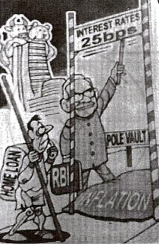Advertisements
Advertisements
प्रश्न

The Central bank is having the authority to regulate the amount of money supply in the economy.
Based on the above explain the following.
- Credit Rationing
- CRR
- Regulation of Margin Requirements
- Bank Rate
दीर्घउत्तर
उत्तर
- Credit Rationing: Rationing of credit is another instrument of selective credit control. It aims at limiting the maximum (ceiling) amount of bank loans and advances. Rationing of credit may take the following two forms:
- The central bank may fix the maximum amount of loans and advances which can be given by a commercial bank.
- The central bank may fix the maximum ratio of loans and advances of a commercial bank to its total deposits.
- Cash Reserve Ratio (CRR): It refers to the minimum percentage of total demand and time depqsits to be kept by commercial banks with the central bank. A change in CRR affects the power of commercial banks to create credit.
- Increase in CRR: An increase in CRR reduces the excess reserves of commercial banks and limits their lending power. In other words, the reserves of commercial banks are reduced and they give less credit. CRR is raised during inflation. The volume of aggregate demand will decrease.
- Decrease in CRR: During the period of deflation (or deficient demand) the central bank decreases the cash reserve ratio. A decrease in CRR has the effect of increasing the banks excess reserves and thus, increases their lending ability. Banks now give more credit. Thus, when credit or money supply is to be expanded, CRR is reduced.
- Regulation of Margin Requirements: Margin requirement refer to the difference between the amount of loan granted and the value of security offered for the loan. Margin is necessary because if a bank gives a loan equal to · the full value of security, then bank will suffer a loss in case of fall in price of security. The central bank influences the availability of bank credit by changing this margin requirement. For exan;iple, suppose for a given house the central bank allows only 70 per cent of the value of a house to be given as loan. The margin requirement in this case would be 30 per cent. If flow of credit is to and selling of government securities (like National Saving Certificates (NSCs) by the central bank from/to the public and banks. OMO are used to influence money supply in the country. It does not matter whether the securities are bought and sold to the public or banks, money ultimately is deposited in or transferred from the banks. Suppose people buy securities, they will withdraw their money from the banks. And when they sell the government securities the money so obtained is deposited in banks.
- Sale of Securities: During the period of inflation, the central bank starts selling government securities in the market. As a result, the cash resources of commercial banks are reduced and they are not in a position to lend more to the businessmen. This reduces the volume of credit and money supply in the economy. The level of aggregate demand starts falling which in tum help in controlling rising price level.
- Purchase of Securities: During deflation, the central bank starts purchasing securities from the open market. Consequently, the excess reserves of commercial banks increase and they give more loans and advances. Thus, when credit is to be expanded the central bank buys the government securities from the market.
- Bank Rate: The discount rate at which a country's central bank rediscounts bills of exchange submitted by commercial banks for loans. It is the interest rate at which commercial banks borrow credit funds from the RBI. The RBI's 'Dear Money Policy' involves increasing bank rates to reduce inflationary pressures. The RBI's "Cheap Money Policy" involves maintaining low bank rates to prevent deflation.
- Increase in Bank Rate: During inflation (i.e., a state of rising of prices), to control the volume of credit, central bank raises its bank rate. This will increase the cost of borrowing by banks. An increase in the bank rate will then cause the banks to raise the rates of interest at which they lend. This will discourage businessmen and others to borrow from them, leading to reduction in the volume of credit and money supply.
- Decrease in Bank Rate: During deflation (i.e., a state of falling of prices), central bank reduces the bank rate. Borrowing from the central bank by commercial banks becomes cheaper. Commercial banks also reduce their lending rates. Businessmen are encouraged to borrow more leading to expansion of credit and hence money supply. This will help to control inflation.
shaalaa.com
Functions of a Central Bank
क्या इस प्रश्न या उत्तर में कोई त्रुटि है?
APPEARS IN
संबंधित प्रश्न
- In the realm of economic development, how does the role of entrepreneurs impact the overall growth and stability of a nation.
Which of the following is/are the function(s) of central bank.
Explain the 'Clearing House Function' of the Central Bank?
Identify which of the following is not the function of the central bank?
Which of the following is not a function of a commercial bank?
The central bank acts as ______.
Identify the function of RBI as indicated by the following image.

Who normally keep their deposits in the Central Bank?
Explain the banker's bank function of the Central Bank.
Name the institution that enjoys the monopoly of note issue in India.
